Clemencing, clemancing, year by year / Apples and pears are very good cheer
November 23: St. Clement's Day (Clementing the Village Green | Benediction)
Clemancing, clemancing, year by year
Apples and pears are very good cheer,
One for Peter, two for Paul,
And three from the man that made us all.
Up with your stocking, and down with your shoe,
If you’ve got no apples, money’ll do.
Clement was a good old man,
For his sake pray give us some.
None of the worst but some of the best,
I pray God send your soul to rest.Tamworth Clementing rhyme1
When I first ‘found’ the liturgical calendar a dozen-odd years ago, it opened up a catechesis of the Christian faith that finally made sense to me…as a person who learns best through sights and sounds and smells, I found that scripture & theology were coming alive in new ways. So, when I see Clement mentioned in Philippians 4, he’s no longer an anonymous name listed on a page - he bears with him the scent of winter citrus and the warmth of wool on cold nights.
The calendar, though, can also become overwhelming; it’s easy to turn it into a checklist, an onslaught of endless feasts that leave us drained rather than enlivened. I’ve written a bit previously about how the Church year is both flexible and local - that the modern tendency to pressure ourselves to celebrate a complete list of all the universal feasts is…well…modern.2
As I’ve mentioned before in this context of liturgical overwhelm, my approach in learning the rhythms of the calendar has been to dive into one new (to me) feast day each month. I file these things away, and then when that month rolls around again next year, I have familiarity to lean on as well as new things to discover. Or if it’s an especially challenging season, I can skip the new things and just stick with the familiar.
All that to say - as I settle into a rhythm here on Substack, my goal is to hold loosely with that approach…journeying alongside you through one feast day (or other topic) each month, giving us an opportunity to really savor it calmly & thoughtfully.
So, as you may have noticed in my previous St. Clement posts, I’m cleaving each month’s topic into several articles: one to welcome us to the feast, its holy figures, and agrarian context; one to further explore traditions of both the Hearthside and the Field & Table; and another to extend those out into the Village Green - bearing these holidays in community.
Today, let’s finish our time with St. Clement by a-Clementing into the Village Green!
Clementing our Village
Clemany! Clemany! Clemany mine!
A good red apple and a pint of wine,
Some of your mutton and some of your veal,
If it is good, pray give me a deal;
If it is not, pray give me some salt.
Butler, butler, fill your bowl;
If thou fillst it of the best
The Lord’ll send your soul to rest;
If thou fillst it of the small,
Down goes butler, bowl and all…Staffordshire Clementing rhyme3
Just as souling during Hallowtide brought celebrants from their homes and into their communities, Clementing was a way for neighbors to take their celebrations of St. Clement into their village. The earliest mention of Clementing dates to 16864, but even as early as 1540, we see a proclamation that children should take part in processions for St. Clement’s Day.5
Bands of children would go door to door, singing a Clementing rhyme - and, in return, they would receive spiced cakes, fruit, or money. Like souling traditions, these door-knocking customs (rowdy at times though they were) helped to secure winter larder, however meager, at a time in the year when those with stored resources had more to share.
The local Blacksmith guilds also adopted Clementing (with St. Clement - “Old Clem” - being their patron saint, recalling the anchor that was the instrument of his martyrdom). They would process around town with an effigy of Old Clem6 held aloft, singing and begging for money; everything they collected went toward a Clem Supper for their guild that evening.
The onset of colder weather and the lengthening of night didn’t provoke a retreat into individual households: it instead stirred a desire for community and a visceral, humbling understanding of the profound inter-dependence of households in these agrarian communities. People who were literally drinking from the same well.
When we’re up against it, when the nights are long and cold and uncertain, we really discover how much we rely upon one another.
In our modern world, if we find ourselves in the fortunate circumstances of having shelter and warmth and a full pantry, we’re insulated from so much of these wintry promptings; but St. Clement, ushering us toward the end of November with long, dark nights, reminds us that comfort is not a foregone conclusion, and that generosity and concern extends beyond the four walls of our home and our island of concerns.
Can we go a-clementing in the modern world and somehow not belabor it? Can we take our at-home Clementide catechesis and bear it forth without the experience feeling artificial, or like a museum-recreation? At Hallowe’en, after all, we have Trick-or-Treating to carry on the torch of souling, to some extent.
Clementing, though, hasn’t remained in the same way. But I do believe it can be a prompt to draw us into our communities at a time when that connection is so intensely needed. And I say that as an introvert; it’s easy for me to set myself up with the wider social aspects of these holidays feeling overwhelming. When I normalize these extensions of myself, though, I find that they instill a default of presence - encouraging me to have an attentive awareness of my surroundings and the needs of the people in them.7 It’s so easy to get stuck in our own ways & habits and not encounter others outside of our parameters of routine.
I wonder if Clementing might be more important now than ever, in this age of the lament of disconnected communities; but that doesn’t mean that we need to go knocking on doors, recreating a 19th century rhyme about St. Clement.
While we should work toward embracing a spirit of generosity every day, these various feast days serve as helpful reminders for a forgetful people - cues to encourage us to reach out and move beyond ourselves. (I want to really emphasize that connecting the traditions and symbolism of these feasts into our community is not about trying to coordinate them for some sort of aesthetic: it’s about acknowledging our forgetfulness and taking the cues where we can find them. And, fortunately, the Church provides!)
I say this knowing full well that it’s a seasonal situation - when we’re in the fortunate circumstance of being able to extend ourselves, let’s try to do so (imperfect though we may be); when we’re in a season of need, mentally or physically, let’s be open to receiving from others. Clementing makes room for both the giver and the receiver; and, throughout life, we will all certainly experience both ends of that spectrum.
Consider a few Clementing ideas with me:
Did you bake a double-batch of last week’s Clementing Cakes? Leave them on the doorsteps of your neighbors - sweet November surprises.
Provide your local food bank with more resources, whether food, money, or time (with citrus in season, maybe stock up on always-beloved oranges to bring! Or bring whatever fresh produce is in-season and abundant in your area)
Donate cold-weather clothing to your local shelter (there’s a legend about St. Clement that, as he fled from Trajan, he placed sheep-wool between his feet and sandals; the heat, moisture, and friction from running turned the wool to felt, and he was thus credited with the invention of felt.8 Maybe this is a helpful reminder to bring warm felt wool gloves to our local shelters?)
In America, with Thanksgiving coinciding with the feast of St. Clement this year, it’s a great reminder to purchase an extra turkey or ham if we can, and find a local church, hospital, or charitable organization to donate it to. Many nonprofits have programs in place to help supply Thanksgiving trimmings to families in need.
Especially if we’re in a season of drawing-in or suffering, and we have no margin left, let’s be open to the offerings of others to us (isn’t it funny how difficult that can be sometimes?) In that season, Clementing may look like simply accepting a warm meal from a friend, re-examining our instinct to isolate (I say this realizing that everyone needs time to process privately, some of us more than others), letting our people know that we need help, saying “yes” to a cup of coffee…or maybe telling a loved one that we need space and quiet. Whatever it is, may we allow ourselves to figuratively go a-clementing to our community, asking with vulnerability and open hands for the needs we have.

And, if you’re so inclined, there’s even a St. Clement’s Day carol!
It was about November-tide,
A long long time ago,
When good St. Clement testified
The faith that now we know.
Right boldly then he said his say
Before a furious king:
And therefore on St. Clement's day
We go a-Clementing.Work in the mines they gave him then,
To try the brave old Saint;
And there two thousand Christian men
With thirst were like to faint.
He prayed a prayer and out of clay
He made the waters spring;
And therefore on St. Clement's day
We go a-Clementing.An anchor round his neck they tied,
And cast him in the sea;
And bravely as he lived he died,
And gallantly went free.
He rests a many miles away,
Yet here his name we sing,
As all upon St. Clement's day
We go a-Clementing.Our fathers kept it long ago,
And their request we make,
Good Christians, one small mite bestow,
For sweet St. Clement's sake;
And make his feast as glad and gay
As if it came in spring,
When all upon St. Clement's day
We go a-Clementing.Clara Erskine Clement, A Handbook of Legendary & Mythological Art (1871)9
Clementide Benediction
“The Flood and the Fruit” - a Benediction for Saint Clement’s Day
byMay the God of the Flood and the Fruit find us gathered at the feet of the Lamb, holding fast in the tide as the waters rise and recede, rise and recede;
May the memory of holy Saint Clement be our anchor in the roiling sea, a sweetness of bells tolling over the waves, the sharpness and reward of winter’s fruit.
Amen.
Thank you for joining me on this Clementide journey…I’d love to hear your thoughts, questions, or curiosities - or if you’ll be celebrating, and if so, how! Blessings, my friends.
Pax vobis,
Kristin
If you’d like to make a one-time donation, I have a PayPal Tip Jar - please know that I’m so grateful for your monetary support, which really does help me continue to do this work that I’m so passionate about!
For those who are able to support a monthly or annual paid subscription, I offer occasional new printables, extra posts, and access to my whole library of printables: the Scriptorium. I’m so grateful for your generosity, which helps to support my work through the purchase of additional books for research, art supplies, and more!
For more reflections and perspectives on the liturgical year, please visit Signs + Seasons: a liturgical living guild!
Recorded in G. F. Northall’s English Folk-Rhymes (1892)
For a beautiful deep-dive into paraliturgy and the Church calendar in its Medieval context, visit this blog post by
: “While paraliturgical activities were commonplace across Medieval Europe, these activities took very different forms in e.g. seventh-century Toledo and fifteenth-century East Anglia. Much like the liturgy itself, paraliturgical movement was very local, rooted in the religious contexts of the time and place where it occurred. Processions, plays, and dances, which often combined secular and religious elements, come to mind–‘paraliturgical movements’ like these continue to characterize European holiday celebrations.”Recorded in G. F. Northall’s English Folk-Rhymes (1892)
Steve Roud, The English Year.
William Hone, The Every-Day Table Book.
You might recall mention of Old Clem from Charles Dickens’ Great Expectations.
Bonnie Blackburn & Leofranc Holford-Strevens, The Oxford Companion to the Year
This carol recounts St. Clement’s entry in Jacobus de Voragine’s The Golden Legend


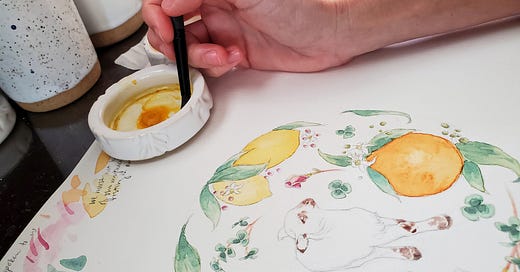




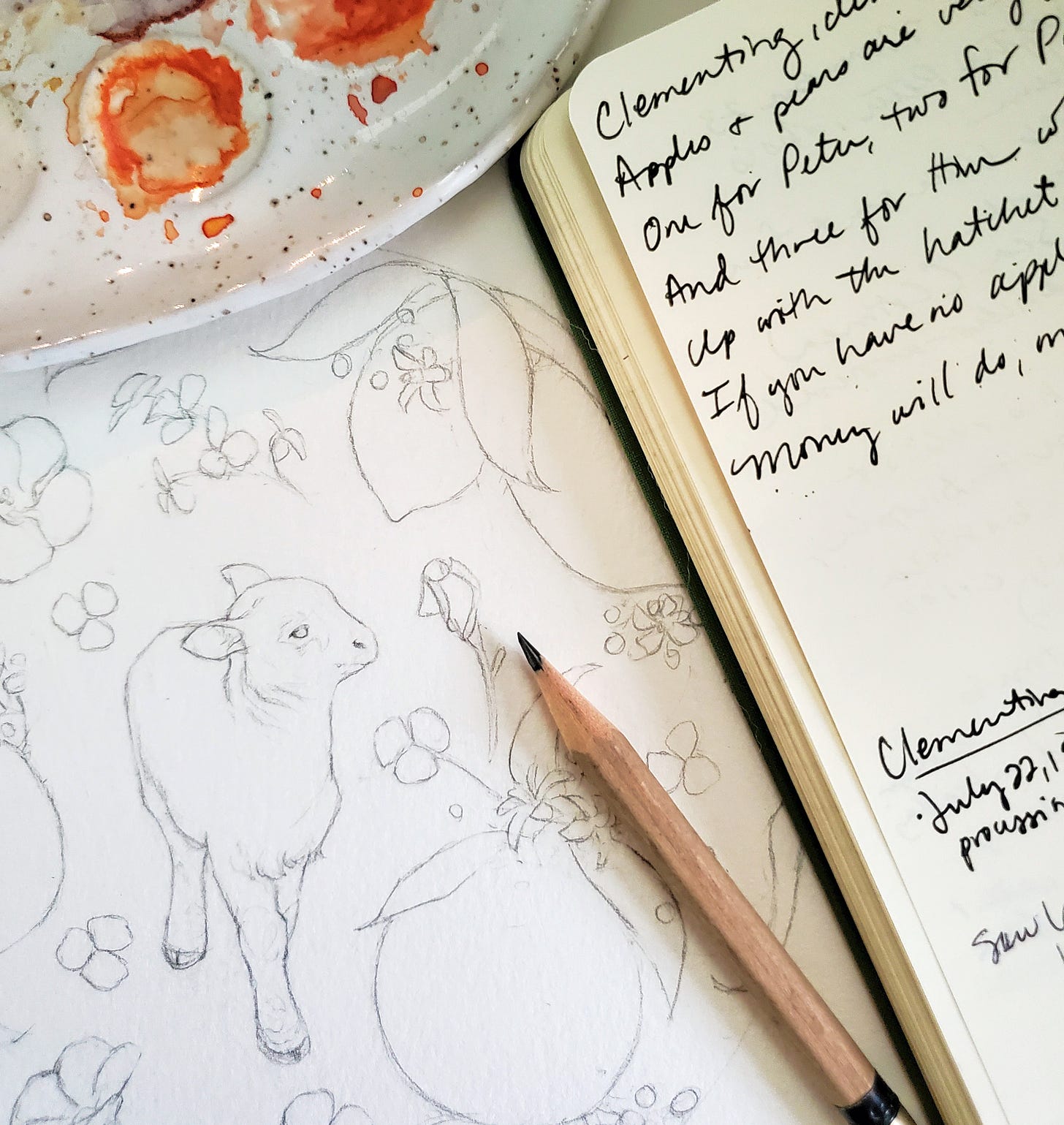
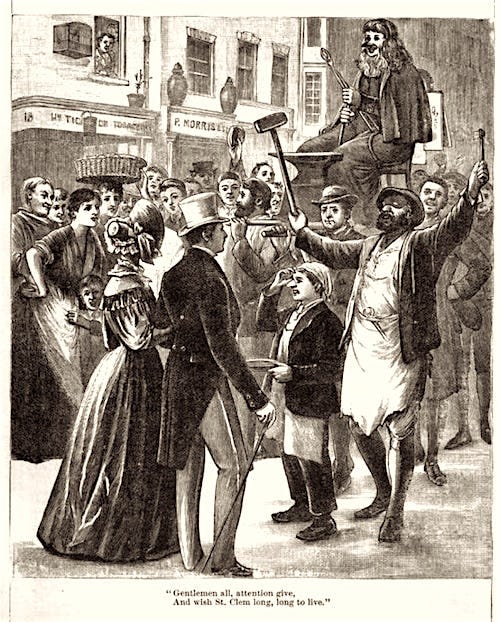
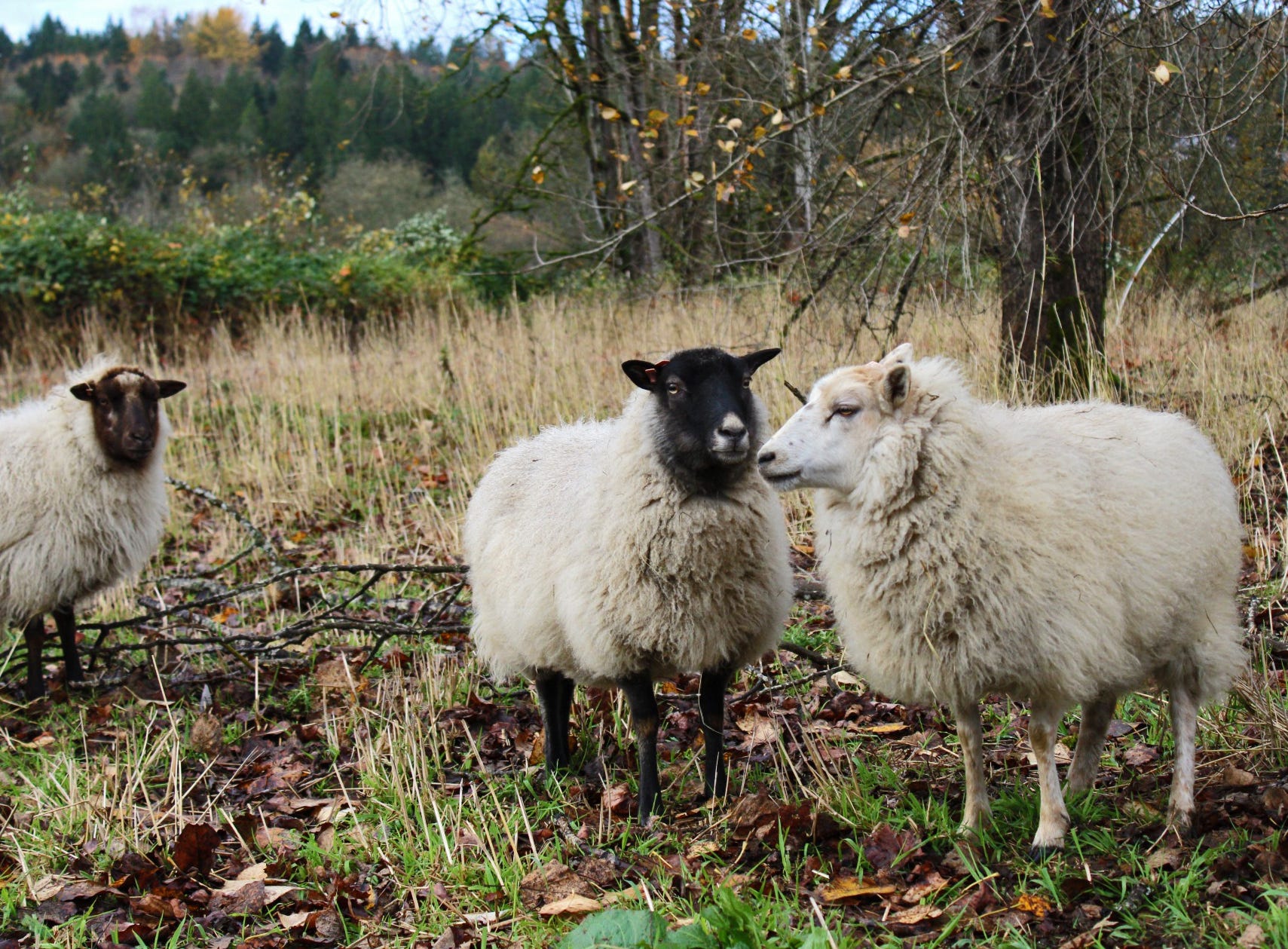

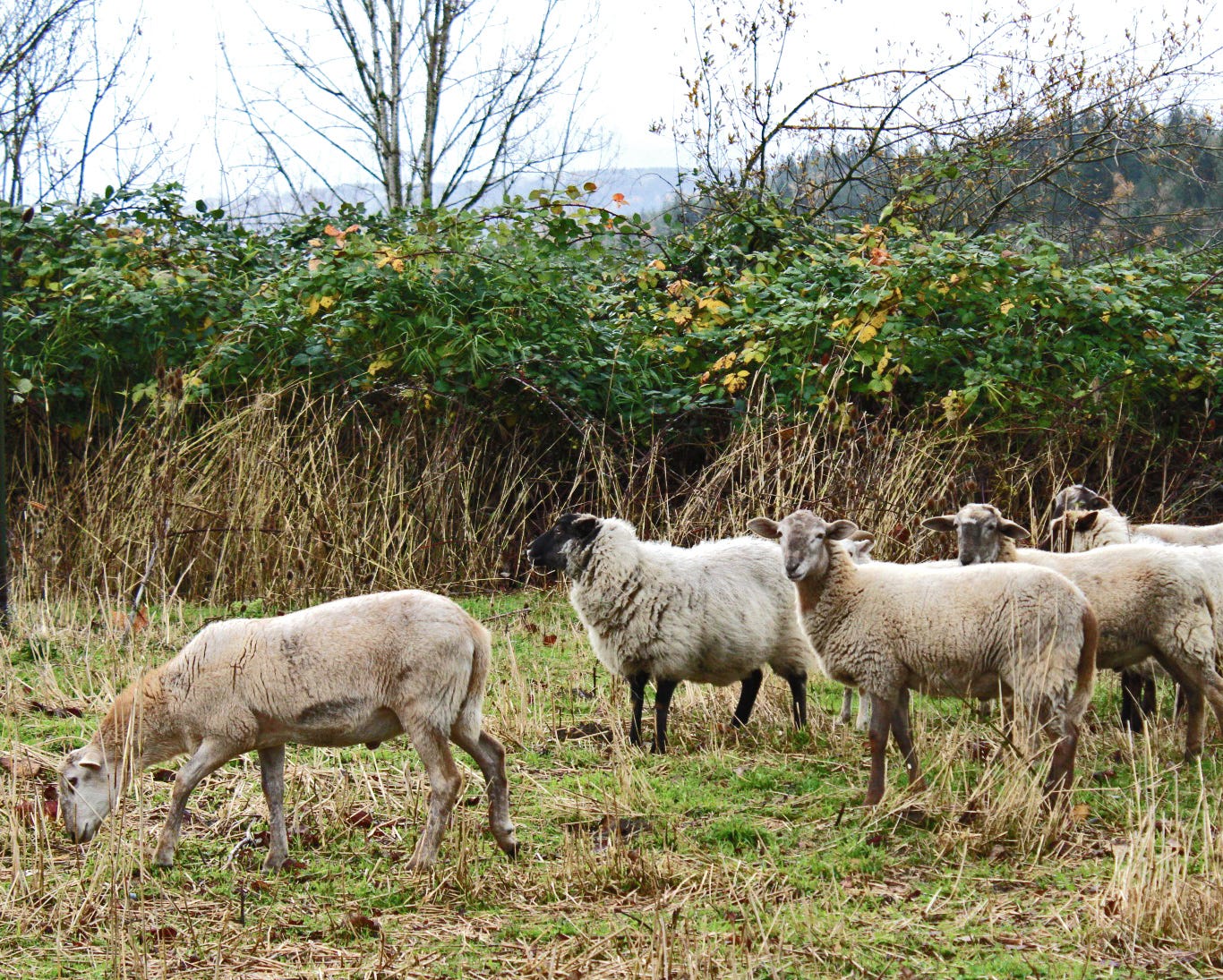
I don't know how I found you, what happy link brought me here, but I'm thrilled I did! Your focus is sorely needed, and you can count me a sub.
The opening lines reminded me immediately of a song I first heard Sting sing on "If on a Winter's Night" album, the song is 'Soul Cake.' I never understood it, but liked it immediately. These words in the chorus aversion of the ones you've highlighted:
"A soul! a soul! a soul-cake!
Please good Missis, a soul-cake!
An apple, a pear, a plum, or a cherry,
Any good thing to make us all merry.
One for Peter, two for Paul
Three for Him who made us all."
Thanks for your writing!
I love what you highlighted about the community piece-- how there is a temptation to just go for an aesthetic, or a "museum" with some of these liturgical feasts, rather than grasping the core of what was being celebrated, and what the celebration provided for people. So the gift of the liturgical feast days as a chance to step out and connect with others! (Or receive the help we need!)